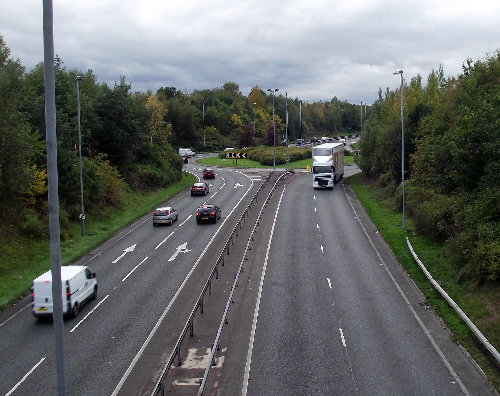Dual-carriageways
 Although the average speed on dual carriageways is higher than on other roads (with the possible exception of motorways) you will still encounter a wide range of hazards, such as cyclists, slow vehicles, traffic lights, cross-roads, side turnings, gateways, etcetera.
Although the average speed on dual carriageways is higher than on other roads (with the possible exception of motorways) you will still encounter a wide range of hazards, such as cyclists, slow vehicles, traffic lights, cross-roads, side turnings, gateways, etcetera.
This means that you must exercise special care, especially when joining and leaving dual carriageways.
In many areas dual-carriageways are now included on 'Learner' test routes. This reflects the nature of new road development across the country.
Driving on dual-carriageways (and motorways) should be easier than driving on other roads because the traffic is only travelling in one direction, therefore your advanced driving test examiner will be expecting a fast 'fluent' drive wherever possible.
To achieve this you will often need to stretch your road-reading skills to the limit, looking for problems well ahead and taking early action to deal with them.
Make full use of the overtaking lane(s) to maximise your progress. This is especially important where hold ups can be predicted. At Junctions, traffic lights and roundabouts look well ahead for heavy vehicles – they will be slow to move away and hold up traffic – take an early lane position to overtake them.
A word of caution. In some places there are regular speed limit changes on dual-carriageways, especially urban areas. Many of the drivers around you will be breaking the speed limit. Avoid getting 'sucked' along with them!
Project
Spend an hour or two on dual-carriageways and try to cover a range of features.
The type of dual-carriageways available in your area will obviously affect the your drive. However, you should try to include at least one dual-carriageway with a national speed limit in force.
If possible, find and negotiate each of the following situations.
-
Acceleration and deceleration lanes
-
T-junction entries and exits
-
Right turn exits
-
Multi-lane roundabouts
-
Traffic splits (specific lanes branching off the dual-carriageway)
Your own project notes
There are no project notes for this section, however apply the same space and speed criteria as on motorways.
It would be a good idea to design your own project sheet – this will be a first step towards developing your lesson planning skills)
Both before and after your drive, use the 'scaling' method to determine any areas for improvement.